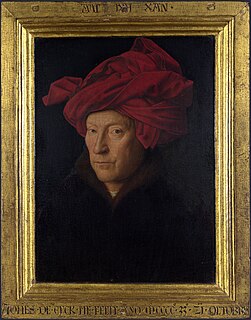
Jan van Eyck was a painter active in Bruges who was one of the early innovators of what became known as Early Netherlandish painting, and one of the most significant representatives of Early Northern Renaissance art. According to Ernst Gombrich, he invented oil painting. The surviving records indicate that he was born around 1380–1390, most likely in Maaseik, in present-day Belgium. He took employment in The Hague around 1422 when he was already a master painter with workshop assistants, and was employed as painter and valet de chambre with John III the Pitiless, ruler of Holland and Hainaut. After John's death in 1425, he was later appointed as court painter to Philip the Good, Duke of Burgundy, working in Lille until he moved to Bruges in 1429 where he lived until his death. He was highly regarded by Philip and undertook a number of diplomatic visits abroad, including to Lisbon in 1428 to explore the possibility of a marriage contract between the duke and Isabella of Portugal.
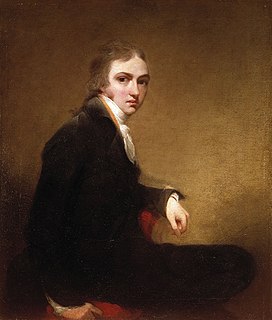
Sir Thomas Lawrence was a leading English portrait painter and the fourth president of the Royal Academy. Lawrence was a child prodigy. He was born in Bristol and began drawing in Devizes, where his father was an innkeeper at the Bear Hotel in the Market Square. At the age of ten, having moved to Bath, he was supporting his family with his pastel portraits. At eighteen he went to London and soon established his reputation as a portrait painter in oils, receiving his first royal commission, a portrait of Queen Charlotte, in 1790. He stayed at the top of his profession until his death, aged 60, in 1830.

Giorgione was an Italian painter of the Venetian school during the High Renaissance, who died in his thirties. He is known for the elusive poetic quality of his work, though only about six surviving paintings are firmly attributed to him. The uncertainty surrounding the identity and meaning of his work has made Giorgione one of the most mysterious figures in European art.

Gentile Bellini was an Italian painter of the school of Venice. He came from Venice's leading family of painters, and at least in the early part of his career was more highly regarded than his younger brother Giovanni Bellini, the reverse of the case today. From 1474 he was the official portrait artist for the Doges of Venice, and as well as his portraits he painted a number of very large subjects with multitudes of figures, especially for the Scuole Grandi of Venice, wealthy confraternities that were very important in Venetian patrician social life.

Ginevra de' Benci is a portrait painting by Leonardo da Vinci of the 15th-century Florentine aristocrat Ginevra de' Benci. It is the only painting by Leonardo on public view in the Western Hemipshere.

Portrait painting is a genre in painting, where the intent is to represent a specific human subject. The term 'portrait painting' can also describe the actual painted portrait. Portraitists may create their work by commission, for public and private persons, or they may be inspired by admiration or affection for the subject. Portraits often serve as important state and family records, as well as remembrances.

Cornelis de Vos was a Flemish painter, draughtsman and art dealer. He was one of the leading portrait painters in Antwerp and is best known for his sensitive portraits, in particular of children and families. He was also successful in other genres including history, religious and genre painting. He was a regular collaborator with Rubens.

Marcus Gheeraerts was a Flemish artist working at the Tudor court, described as "the most important artist of quality to work in England in large-scale between Eworth and van Dyck" He was brought to England as a child by his father Marcus Gheeraerts the Elder, also a painter. He became a fashionable portraitist in the last decade of the reign of Elizabeth I under the patronage of her champion and pageant-master Sir Henry Lee. He introduced a new aesthetic in English court painting that captured the essence of a sitter through close observation. He became a favorite portraitist of James I's queen Anne of Denmark, but fell out of fashion in the late 1610s.
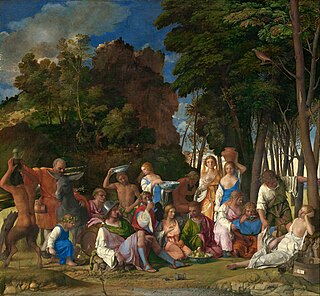
The Feast of the Gods is an oil painting by the Italian Renaissance master Giovanni Bellini, with substantial additions in stages to the left and center landscape by Dosso Dossi and Titian. It is one of the few mythological pictures by the Venetian artist. Completed in 1514, it was his last major work. It is now in the National Gallery of Art in Washington D.C., which calls it "one of the greatest Renaissance paintings in the United States".

Cornelis or Cornelius Ketel was a Dutch Mannerist painter, active in Elizabethan London from 1573 to 1581, and in Amsterdam till his death. Ketel, known essentially as a portrait-painter, was also a poet and orator, and from 1595 a sculptor as well.

Portrait of a Cardinal, or simply The Cardinal, is an oil on panel painting by the Italian Renaissance artist Raphael, dated to c. 1510–1511. It is held by the Prado Museum in Madrid.

John Wollaston was an English painter of portraits who was active in the British colonies in North America for much of his career. He was one of a handful of painters to introduce the English Rococo style to the American colonies.

Jeremiah Theus was a Swiss-born American painter, primarily of portraits. He was active mainly around Charleston, South Carolina, in which city he remained almost without competition for the bulk of his career.
Henry Raeburn Dobson was a Scottish portrait and landscape painter from Edinburgh who was active in Edinburgh and Brussels from 1918/1920 until 1980. His father Henry John Dobson (1858–1928) and his brother Cowan Dobson (1894–1980) were genre and portrait painters. His portraits are mainly painted in oil, while his landscape paintings are mainly painted in watercolour.
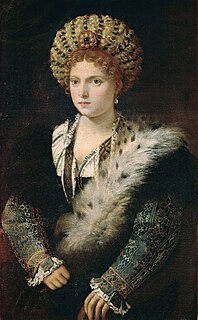
Portrait of Isabella d'Este is an oil-on-canvas painting by the Italian painter Titian, completed between 1534 and 1536. It shows the Marquess of Mantua, Isabella d'Este, daughter of Ercole I d'Este, Duke of Ferrara, and Eleanor of Naples with an ermine zibellino draped over her shoulder.

Léal Souvenir is a small oil-on-oak panel portrait by the Early Netherlandish painter Jan van Eyck, dated 1432. The sitter has not been identified, but his highly individual features suggest a historical person rather than the hypothetical ideal usual at the time in northern Renaissance portraiture; his slight and unassuming torso is contrasted with a sophisticated facial expression. His features have been described as "plain and rustic", yet thoughtful and inward-looking. A number of art historians, including Erwin Panofsky, have detected mournfulness in his expression. The sitter was apparently significant enough a member of the Burgundian duke Philip the Good's circle that his court painter portrayed him.

The Boy is an oil painting by Italian artist Amedeo Modigliani created in 1919. It is currently part of the permanent collection at the Indianapolis Museum of Art.

Hans Holbein the Younger painted the Portrait of Erasmus of Rotterdam several times, and his paintings were much copied, at the time and later. It is difficult to disentangle Holbein's original work from that of his workshop and other copyists. Possibly five largely original versions survive, as well as a number of drawings made as studies.
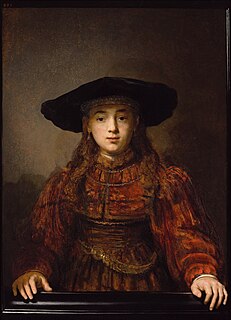
The Girl in a Picture Frame is a 1641 oil on panel painting by the Dutch artist Rembrandt. It is also known as The Jewish Bride and The Girl in a Hat. With The Scholar at the Lectern and Landscape with the Good Samaritan, it is one of three Rembrandt paintings in Polish collections. It is currently located at the Royal Castle in Warsaw.
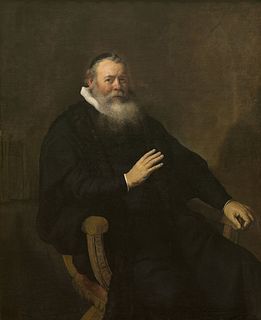
The Preacher Eleazar Swalmius is a 1637 oil on canvas painting by the Dutch artist Rembrandt. It is currently owned by the Royal Museum of Fine Arts in Antwerp. The painting has been certified a real Rembrandt. The painting was listed in 1727 in the catalog of the Duke of Orléans collection, as a portrait of an Amsterdam mayor by Rembrandt. It remained in the noble family's possession until 1792, when Duke Louis-Philippe-Joseph sold the entire collection to finance his political career and pay off debts. The painting passed through several English collections into the hands of the Bourgeois brothers, art dealers from Cologne, who sold the painting as an original Rembrandt to the museum in 1886. The painting was stored away for a long time due to doubts cast over its authenticity.



















